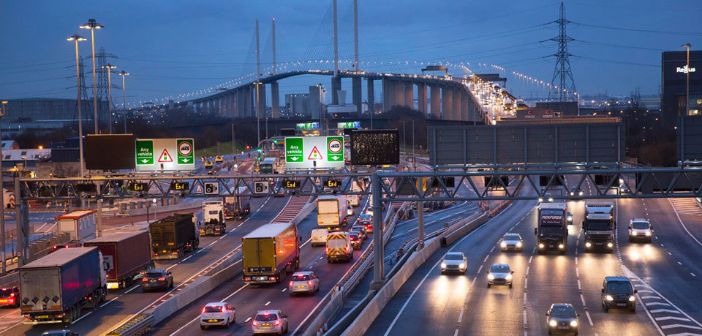A new survey has revealed that almost nine out of 10 Dart Charge business account holders support the Lower Thames Crossing, which is designed to relieve congestion and improve air quality by diverting over 13 million vehicles away from Dartford every year.
The Dart Charge business account survey found that 88% of the 2,299 businesses who responded to the survey support the proposed crossing. The update comes as new data released by Highways England today revealed the Dartford Crossing is over design capacity.
According to the survey, some 82% believe that current traffic congestion is a major challenge for their business, and 89% said they would value an alternative road crossing of the River Thames, east of the Dartford Crossing. The businesses surveyed included household names, major industry and small businesses from across the UK.
Dave Lilly, proprietor of Lilly Transport, said: “We lose up to 20 hours a week on each vehicle due to congestion. The Lower Thames Crossing will provide major relief by removing a large amount of traffic travelling east from the present crossings.”
The proposed Lower Thames Crossing will almost double road capacity between Kent, Thurrock, Havering and Essex. According to Highways England, it will also improve air quality across the region, create over 500 hectares of improved habitats for wildlife, as well as new green spaces for local communities including a community woodland, two new public parks, and over 46km of new or improved public pathways.
Highways England is in the middle of its Community Impacts Consultation for the Lower Thames Crossing, which runs from 14 July until 08 September, before submitting a Development Consent Order application later this year. If given the green light, construction is expected to start in 2024 and take around six years, with a target opening date between 2029 and 2030.
Highways England said it believes “the case for the Lower Thames Crossing is stronger than ever” after new data showed that, despite the restrictions put in place in England during the Covid-19 pandemic, the Dartford Crossing regularly carried more traffic than it was designed for and now carries more food and goods than ever before.
Built almost 60 years ago, the Dartford Crossing has a total design capacity of 135,000 vehicles a day, but carries more than 180,000 on its busiest days. Regarded as one of the UK’s most important strategic roads, linking some of the country’s key manufacturing centres, distribution hubs and ports, demand on the Dartford Crossing remained high throughout the pandemic.
Goods vehicles travelling through the crossing continued to play a vital role moving essential goods to supermarkets and homes. With changing working and shopping patterns in England, 42% of vehicles using the Dartford Crossing are now goods vehicles, compared with 33% in 2019. The data also revealed that Dartford Crossing traffic has now returned to levels last seen before the pandemic, as traffic flows have rapidly bounced back to overcapacity.
Matt Palmer, executive director for the Lower Thames Crossing, said: “Despite improvements and 24-hour monitoring, the Dartford Crossing is still over design capacity and that inevitably causes congestion and delays.
“The Lower Thames Crossing would almost double road capacity crossing the Thames east of London, providing a reliable connection that will add billions to the economy.
“But it also has a more immediate role in the economic recovery from Covid-19 by creating tens of thousands of jobs and hundreds of opportunities for local people and businesses in its construction.”





